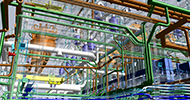These are truly fascinating times for the manufacturing industry.
On the one hand, the world is at the beginning of the fourth industrial revolution (Industry 4.0). A range of next-level technologies, from autonomous robots to the Industrial Internet of Things (IIoT), is transforming the industry – from the way we work, to the factories we work in, to the levels of productivity that manufacturers can deliver.
On the other hand, the industry faces numerous, well-documented challenges, including:
- Implementing Industry 4.0 technologies and platforms
- Increasing capacity to meet growing market demand
- The skilled labour gap and attracting the next generation of manufacturers
- Legacy systems now particularly outdated in the smarter manufacturing era
There are obviously many factors involved when it comes to capitalising on the opportunities of digital transformation and dealing with these challenges. But at the heart of both issues is the drive to make manufacturing smarter.
What is smart manufacturing? On one level, it’s an extension of the old adage ‘work smarter, not harder’, or ‘do more with less.’ This is achieved by increasing manufacturing efficiency and agility, primarily through more advanced technologies and connected operations/systems. And the key element here is data.
Making manufacturing smarter relies on removing data silos, establishing feedback loops that drive continuous improvement, and making the most of your data and the insights it offers. In short, getting the right data to the right people at the right time.
As well as driving digital transformation and strengthening organisations’ capabilities to meet the above industry challenges, this means manufacturers are well-positioned to drive cost-savings, sustainability, profitability, and competitiveness.
The journey to smart manufacturing doesn’t necessarily begin with a huge technology overhaul. In fact, we recommend manufacturers start small and scale fast with a step-by-step approach. That’s why it’s important to make the most of the potential of your existing machine data, which offers opportunities to start your digital transformation today.
How machine data drives smarter manufacturing
Monitoring tools that provide real-time machine data and aggregated historical data enable you to make more informed analyses and understand how patterns of machine performance might indicate servicing needs. For example, perhaps a single coordinate measuring machine (CMM) is frequently identified as a source of downtime or its operational speed is slowing over time while performing the same routines. In such instances, you might conclude from the data that the CMM needs a retrofit or upgrade to bring it back up to specified performance.
Upgrading the machine with the latest software or CNC system, for example, helps to extend its service life. As such, machine data is essential to establishing a proactive rather than reactive approach to machine maintenance and upgrades, as well as getting the most out of your machine throughout its service life.
As already mentioned, machine data can give you insight into where hold-ups are occurring in the product lifecycle. In addition, when connected across multiple assets and plants, monitoring tools should enable you to quickly identify spare capacity. Combining these two uses of machine data is a powerful way of overcoming – and in some cases avoiding – bottlenecks in the manufacturing process.
With machine performance enhanced and sources of downtime rectified, it is likely that data has now helped to shorten cycle times. Furthermore, with real-time machine data you can dig deeper into processes and explore additional opportunities to drive efficiency. Let’s say an operations manager is exploring the data from a specific inspection routine across a number of executions. By analysing execution time statistics and pass/fail results, for example, across different assets, the operations manager will gain a deeper understanding of how key variables (machine, part, etc.,) are impacting cycle times. From there, they can use the data to make more informed decisions with a view to shortening cycle times.
A key element of the smarter manufacturing vision is technology operating autonomously. This has a multitude of benefits – reducing human error and lights out manufacturing to name just two – and one that is particularly good news for operators is how this will enable them to work away from machines on more value-added activity. This in turn has compounding benefits for the organisation, but real-time data is needed for operators to work away from the machine with confidence. The monitoring solution should provide operators with real-time notifications via smartphone or tablet so they can check on machine status and job progress, plus alerting them of any problems that need manual intervention.
If you would like to upgrade your system to drive smart manufacturing, contact us about an upgrade or retrofit.














